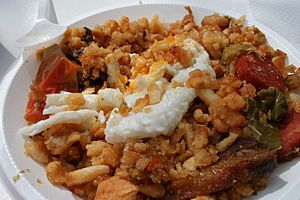Migas facts for kids

Migas Manchegas
|
|
| Alternative names | Migajas |
|---|---|
| Course | Appetiser |
| Place of origin | Iberia |
| Serving temperature | Warm |
| Main ingredients | Bread |
Migas (pronounced MEE-gahs) is a tasty dish from Spain and Portugal. The word "migas" means "crumbs" in English.
Long ago, shepherds first made this dish. It became very popular across the Iberian Peninsula (Spain and Portugal). Hunters in southern Spain often eat migas for breakfast.
There is also a different dish called Migas in Mexico and Tex-Mex cuisine.
Contents
Migas in Spain and Portugal
Spanish Migas: A Dish of Leftovers
Migas is a traditional Spanish food. It was first a breakfast dish. People made it using leftover bread or flatbreads called tortas. Today, you can often find migas served as a first course for lunch or dinner in Spanish restaurants.

The ingredients for migas can be different depending on where you are in Spain.
- In Extremadura, people use day-old bread soaked in water. They add garlic, paprika, and olive oil.
- In Teruel, Aragon, migas often includes chorizo (a type of sausage) and bacon. It is often served with grapes.
- In La Mancha, migas manchegas is a more detailed version. It uses similar ingredients to the Aragonese style.
In southeastern Spain, like Granada, Almería, and Murcia, migas is made differently. It uses flour and water, not bread. It is similar to North African couscous. This type of migas often includes different ingredients, even fish. Andalusian migas is sometimes eaten as a tapa (a small snack) with sardines. In Granada and Almería, people traditionally make migas when it rains.
Portuguese Migas: Bread or Potatoes
Migas is also a traditional food in Portuguese cuisine. It is usually made with leftover bread. In the Alentejo region of southern Portugal, they use wheat bread. In Beira, they use corn bread.
Sometimes, in Alentejo, migas can be made with potatoes instead of bread. This is called migas de batata.
Garlic and olive oil are always used. Other ingredients can include pork fat, wild asparagus, tomato, and spices like red pepper paste and fresh coriander. In Beira, people often add cooked kale, beans (like pinto or kidney beans), and sometimes cooked rice.
Portuguese migas is usually served with meat or other main dishes.
Migas in North America
Mexican Migas: A Breakfast Treat
In different parts of Mexico, migas is a common breakfast dish. It is made with corn tortilla strips. These strips are fried until they are almost crispy. Then, eggs are added to make a scrambled egg and fried tortilla mix. This is a great way to use up hardened corn tortillas from other meals.
A similar dish is called Chilaquiles. It uses salsa instead of eggs. Both migas and chilaquiles are filling and inexpensive breakfast meals.
Mexico City Migas: A Special Soup
Mexico City has its own unique version of migas. It is a garlic soup that is made thicker with slices of day-old bread called bolillos.
This soup often gets its flavor from pork shanks, ham bones, and herbs like epazote and oregano. Different types of dried chilies are also added. When the soup is served, a raw egg is usually put into each bowl. The warm soup slowly cooks the egg, much like egg drop soup.
Tex-Mex Migas: More Ingredients
There is also a Tex-Mex version of Mexican migas. This one includes extra ingredients. These can be diced onions, sliced chile peppers, diced fresh tomatoes, or cheese. People also add different spices and sauces, like salsa or pico de gallo. Another common way to make it is to add chorizo sausage to the usual ingredients.
Tex-Mex migas is typically served with refried beans. People often use corn or flour tortillas to wrap all the ingredients into tacos. Migas breakfast tacos are very popular in Texas.
See also
 In Spanish: Migas para niños
In Spanish: Migas para niños



